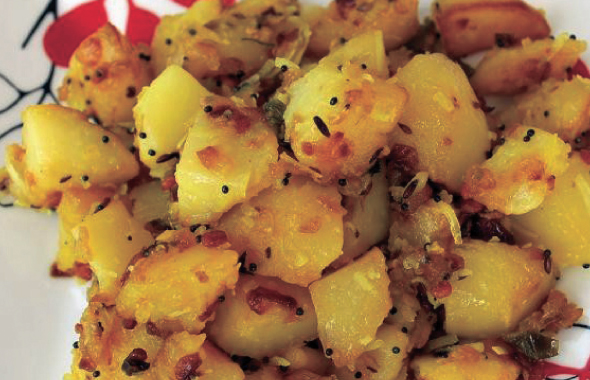Mama’s Punjabi Recipes – Aaloo Di Bhurji (Chopped Potato & Onion Sautee)
The lowly aaloo (potato) is probably one of the most commonly eaten vegetable in the world and is certainly one of the cheapest. It is found just about everywhere; there are stunted, small varieties found even among the sand soils of the desert in Rajasthan and West Africa where potatoes are especially pricey. Due to the loss of the potato crops to a disease in the Irish Famine between 1845 and 1852, there was a huge migration of people from Ireland to the US in the mid-1800s.
Potatoes are generally very high in carbohydrates (about 26gm in a medium potato) predominantly in the form of starch, both of which can contribute to weight gain. A small but significant amount of starch is resistant to digestion by enzymes, and remains in the large inte stine intact as fiber which provides bulk and protects against colon cancer. Potatoes are classified as high glycemic and so are not suited to individuals on a low sugar diet.
A medium size potato with the skin provides 27mg of vitamin C (45% of the Daily Value), 620mg of potassium (18% of DV), 0.2mg of vitamin B6 (10% of DV) and trace amounts of other minerals and vitamins.
Indians love potatoes in one form or the other, and usually these are overcooked in curries which are eaten with other starchy items like rice or breads; or in fried foods which are saturated in oils and although these dishes are tasty, they are fattening. This recipe not only uses a small amount oil, it is also very fast to make.
Ingredients:
2 large aaloo (potatoes) – red or plain, but not the baking kind
1 medium pyaaz (onion) – yellow or white
1 tbsp tael (olive oil or vegetable oil)
Spices: ½ tsp haldi (turmeric), 2 tsp dhania (coriander powder), ½ tsp garam masala, 1 tsp lal mirch (red pepper) and salt to taste.
Directions:
1. Peel and chop the potatoes into ½ inch pieces, then wash them and let them soak in cold water in a bowl.
2. Peel and chop the onions also into ½ inch pieces and place in a medium skillet with the oil over medium heat till they are slightly brown. Do not overcook as the onions will lose their taste. Add the haldi, lal mirch and salt and stir.
3. Take the sliced potatoes out of the water and add to the skillet. Stir and cover the skillet over low heat for two minutes. Remove the cover and check if the potatoes are cooked; if not then cover for another minute.
4. Add the garam masala and dhania and stir. If you use fresh dhania, the taste will be much better. Cover the skillet and turn the heat off and let it sit for five minutes. This dish tastes best with warm roti.
Shakuntla Malhotra is a skilled cook of Punjabi dishes made in the old-fashioned style that she learnt as a young woman in her ancestral home in Lyallpur, India before it became part of Pakistan after the Partition in 1947. People have often admired her cooking for its simplicity and taste that comes with each mouthful. Even in her mid-eighties, she continues to cook daily and agreed to share some of her delectable Punjabi recipes.
MAMA’S TIP OF THE WEEK
HOW TO GET RID OF HALDI STAINS ON CLOTHES
When cooking or serving Indian food, one of the biggest concerns for hosts and restaurateurs is the curry stains that are left on tablecloths and napkins. The biggest culprit is haldi (turmeric) which leaves a yellow stain, the reddish tinge is usually from the tomatoes and red pepper in the food. There is a simple way to get rid of these stains, especially if these are fresh, but this method also works fairly well on older stains, even left overnight. First wash the cloth in regular water, then place the stained part of the cloth in bright sunshine for an hour or two and the stain will disappear!


